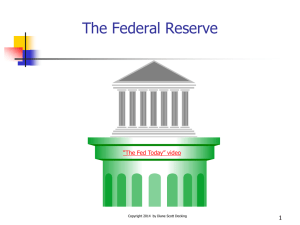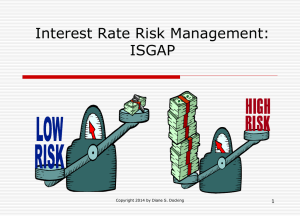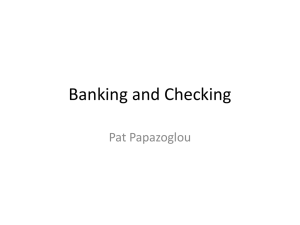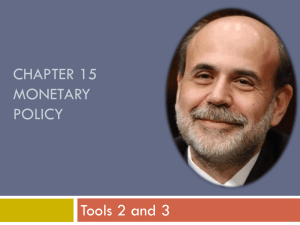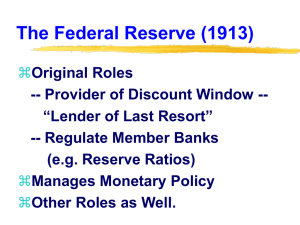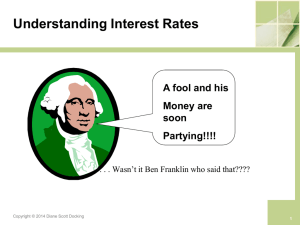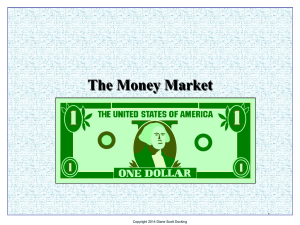Tools of Monetary Policy
advertisement
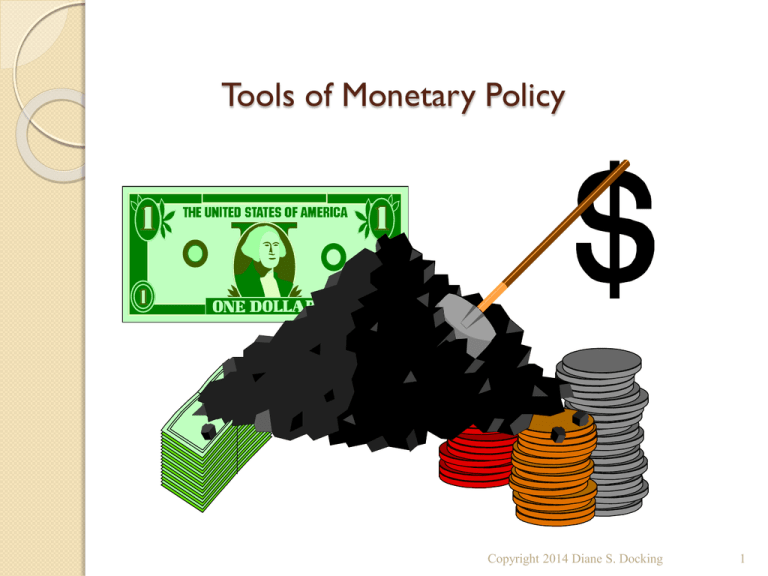
Tools of Monetary Policy Copyright 2014 Diane S. Docking 1 Learning Objectives Understand the monetary policy tools used by the Fed. Copyright 2014 by Diane Scott Docking 2 The Federal Reserve and the Money Supply The Federal Reserve controls the Money Supply by controlling the amount of transaction deposits in the banking system. ◦ If the Fed wishes to increase (decrease) the Money Supply, it increases (decreases) deposits. Copyright 2014 Diane S. Docking 3 Tools of Monetary Policy Tools of Monetary Policy Copyright 2014 Diane S. Docking 4 Copyright 2014 Diane S. Docking 5 Changing the Required Reserve Ratio Copyright 2014 Diane S. Docking 6 How Fed Controls Money Supply via Required Reserve Ratio Banks must maintain reserves as percent of deposits Reserves kept as deposits in Fed (plus vault cash) Fed controls level of deposits by setting the “required reserve ratio.” Copyright 2014 Diane S. Docking 7 Reserve Requirements A decrease in RR → increase in Supply of Loanable Funds (LF) → decrease in Interest rates (assuming demand stays constant). An increase in RR → decrease in Supply of Loanable Funds (LF) → increase in Interest rates (assuming demand stays constant). • Rarely used as a tool 1. Raising causes liquidity problems for banks 2. Makes liquidity management unnecessarily difficult Copyright 2014 Diane S. Docking 8 Reserve Requirements Advantages ◦ 1. Powerful effect Disadvantages ◦ 1. Small changes have very large effect on Ms ◦ 2. Raising causes liquidity problems for banks ◦ 3. Frequent changes cause uncertainty for banks ◦ 4. Tax on banks Copyright 2014 Diane S. Docking 9 Changing the Discount Rate Copyright 2014 Diane S. Docking 10 Changing the Discount Rate A decrease in DR → increase in borrowing by banks →increase in Supply of Loanable Funds (LF) → decrease in Interest rates (assuming demand stays constant). An increase in DR → decrease in borrowing by banks → decrease in Supply of Loanable Funds (LF) → increase in Interest rates (assuming demand stays constant). Copyright 2014 Diane S. Docking 11 Open Market Operations Copyright 2014 Diane S. Docking 12 Open Market Operations Open market operations involve the purchase or sale of government securities based on FOMC directives sent to N.Y. Fed Trading Desk Open market purchase of government securities: ◦ Fed purchase of securities results in an injection of additional funds into the bank system Increases supply of federal funds, which Lowers federal funds rate, which leads to Lower rates spread to other money market securities ◦ More funds available for money market and bank lending ◦ Increase bank deposits and bank reserves, money market liquidity and, in time… ◦ Increases the money supply Copyright 2014 Diane S. Docking 13 Example: Deposit Creation Using Required Reserve Ratio & Open Market Operations by Fed See Example reading Copyright 2014 Diane S. Docking 14 Deposit Creation The maximum number of dollars in new deposits that result from the Fed’s action is: TD k initialinfusion or TD k initialcontraction where k is called the “deposit multiplier” and rr is the “required reserve ratio”. 1 k rr Copyright 2014 Diane S. Docking 15 Deposit Creation in the Banking System The lower the required reserve ratio, the greater the deposit multiplier and its effect on deposits. This model of multiple deposit creation ignores the fact that: ◦ The public may desire to hold money in the form of ____________ instead of transaction deposits ◦ The bank may choose to hold ______________ and not loan out all of the money. ◦ If this is the case, then the deposit multiplier is smaller than if excess reserves = 0 and currency = 0. Copyright 2014 Diane S. Docking 16 Deposit Creation in the Banking System Excess Reserves = ER = e x TD ; where e = percentage of transaction deposits held as excess reserves; i.e., e = $E/$TD Level of Currency = C = c x TD ; where c = percentage of transaction deposits held as currency; i.e., c = $C/$TD “e” and “c” are referred to as ___________ Copyright 2014 Diane S. Docking 17 Deposit Creation in the Banking System If e 0 and c 0, then the deposit multiplier is: 1 k = rr + e + c Copyright 2014 Diane S. Docking 18 Monetary Policy Suppose reserves are $2 billion and the Fed increases reserves by 1% or $20 million when bank reserve requirements are 10%. What is the predicted increase in bank deposits? 1 TD $20 million $200 million 0.10 TD new 2 billion 200 million $2.2 billion Copyright 2014 by Diane Scott Docking 19 Monetary Policy Suppose that instead of changing the $2 billion in reserves the Fed reduces the reserve requirement from 10% to 9%. What is the predicted increase in bank deposits? Initial infusion 1% of $2 billion $20 million 1 ($20 million) $222 million 0.09 TD new $2 billion 222 million $2,222,000,000 Copyright 2014 by Diane Scott Docking 20 Example: Deposit and Reserve Contraction Suppose the Treasury Decides to sell $1,000,000 worth of T-Bills. How will this ultimately affect the banking system? Copyright 2014 Diane S. Docking 21
